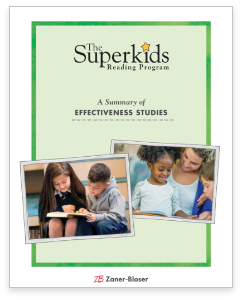


Welcome, Oklahoma Educators!
Here you will find resources to help you review The Superkids Reading Program, an Oklahoma-approved ELA program, during the 2021–2022 adoption.

Success in beginning reading is key to reading success later in the intermediate grades. Crafted specifically for grades K–2, Superkids teaches all aspects of reading with a focus on the alphabetic principle. This phonics-based, explicit, systematic approach is exactly what young children need.
Schools with split adoptions for grades K–2 and 3–6 recognize what the science of reading confirms: How primary students learn to read is different, and how they’re taught matters. Read The Case for a K–2 Reading Program for the research basis of splitting your adoption.
Comprehensive, Research-Based Instruction
K–2 Instruction
The Superkids Reading Program lessons incorporate all aspects of reading and the language arts, integrating and overlapping skills from unit to unit and grade to grade.
Download the Overview Brochure to get to know the program’s Word Work, Reading, and Writing lessons. For a complete listing of skills by grade and unit, download the Skills Overview. These skills are taught and practiced recursively.
Superkids makes every minute of your ELA block count. Download the Daily Instructional Plan to see the program’s easy-to-follow plan for bringing the science of reading to life each day.
Research
To learn how Superkids teaches foundational skills, reading, writing, language skills, and speaking and listening in evidence-based ways, read the foundational research.
How Can I Help You?
If you would like to request samples, a presentation, a quote, or anything else, I’m here to help.
Request Samples
SALES CONSULTANT – SUPERKIDS READING
281.415.0836
carol.bradford@zaner-bloser.com

SALES CONSULTANT – SUPERKIDS READING
281.415.0836
carol.bradford@zaner-bloser.com
Oklahoma Reviewer Resources and Samples
If you already have Superkids samples in hand, you may find these videos and online resources helpful to get a complete understanding of program materials.
Sample Kit Walk-Through Videos
MyZBPortal.com
Use the credentials below to log in to MyZBPortal.com and review the program’s online resources.Log in here
Username: skoklahoma@zaner-bloser.com
Password: Literacy

Correlations to the Oklahoma Academic Standards for English Language Arts
View Grade K View Grade 1 View Grade 2Correlations to the Oklahoma Academic Standards for English Language Arts: Lesson Plan Format
View Grade K, Semester 1 View Grade 1, Semester 1 View Grade 2, Semester 1 View Grade K, Semester 2 View Grade 1, Semester 2 View Grade 2, Semester 2Support for Remote Learning
Video lessons save teachers time and allow students at home the flexibility to watch and learn at different times. Videos also help ensure consistency when used for instruction by substitute teachers. Review a sample video for each grade level.
Success in Schools and Districts
Read the case study reports below to discover how an Oklahoma school and districts across the U.S. are achieving results with Superkids.
Will Rogers Elementary School—located in Washita County, Oklahoma
Read Case Study
Matthews Elementary School—turn-around school
Read Case Study
Wausau School District—LETRS®-trained teachers
Read Case Study
Gurnee School District 56—15.3% English language learners
Read Case Study
School District 27J—LETRS®-trained teachers
Read Case Study
Littleton Public Schools—large district
Read Case Study
View more Superkids case studies.
Experts Weigh in on Superkids
Structured literacy experts Sally Shaywitz, author of Overcoming Dyslexia, and Nancy Hennessy, past president of the International Dyslexia Association, have both written letters of support for Superkids. Read their affirming words below.
Efficacy Research
A large body of evidence shows that The Superkids Reading Program is highly effective in improving reading achievement for K–2 students of all backgrounds in all types of schools.
Read about the scientific research covering many years, regions of the U.S., and student populations in “A Summary of Effectiveness Studies.”

